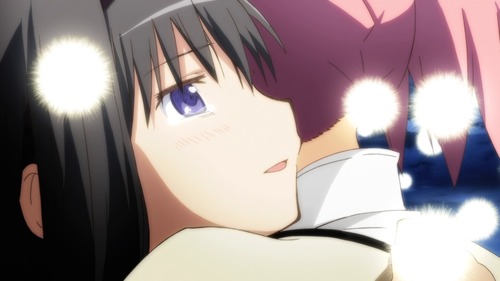What's the story, Wishbone?

How Madoka: Rebellion shows that patching isn’t just for video games, and why that’s a good thing, after the break. Spoilers ahoy!
Continue reading
If you’ve been reading this blog for a while, you may recall that I did not like the ending of the original Madoka TV series. In short, even if the title character’s power to make a game-changing wish was consistent with the universe’s internal rules, it seemed to come so far out of nowhere that it undermined the emotional narrative that the rest of the series had taken its time to so painstakingly establish.
I loved The Rebellion Story’s conclusion, on the other hand, and not simply because it was dark or contrarian – it actually reaches back in time, in appropriately Homura-esque fashion, to fix the sins its predecessor committed. Logically speaking, after all, Homura’s countless attempts to save Madoka should have inflicted their trauma on her in equal measure to the power it lent Madoka’s wish. Rebellion ultimately makes good on this promise, by using that trauma to transform Homura into an entity powerful enough to counter what Madoka became at the end of the TV series. In the process, it changes what had been a one-off deus ex machina into a pattern identifiable through the narrative alone. The sequel, in essence, justifies its own presence by retroactively rewriting the frame through which we see the original.
Not that this is the only thing that Rebellion has going for it. One of my favorite things about long-running SHAFT productions is the way they gradually construct a visual language with each installment, applying the same underlying principles to new settings. Bakemonogatari revealed its visual world in layers, starting with Meme Oshino’s hangout, then moving outward and upward in scope from a single building to a whole urban metropolis in its final arc. Rebellion does much the same thing, taking the unreality of a witch’s labyrinth and magical combat and painting it on the scale of all of Mitakihara City. And again, this all ties back into the narrative – the eye-popping magnitude of the movie’s battles isn’t just for show, but a subtle hint at the containment of the entire world inside an artificial magical realm. The backhanded illumination of the unnatural contortions you’d have to perform to get a “utopian” setting, where the girls all just get along happily, is just icing on the cake.
I’d previously have said that the original Madoka series was good television, but only with some major caveats. With Rebellion, though, the franchise has turned what were once narrative flaws completely on their head. When I talk about endings, I don’t care about whether they’re happy or sad, just whether they’re fitting. In my book, then, this is a good ending.